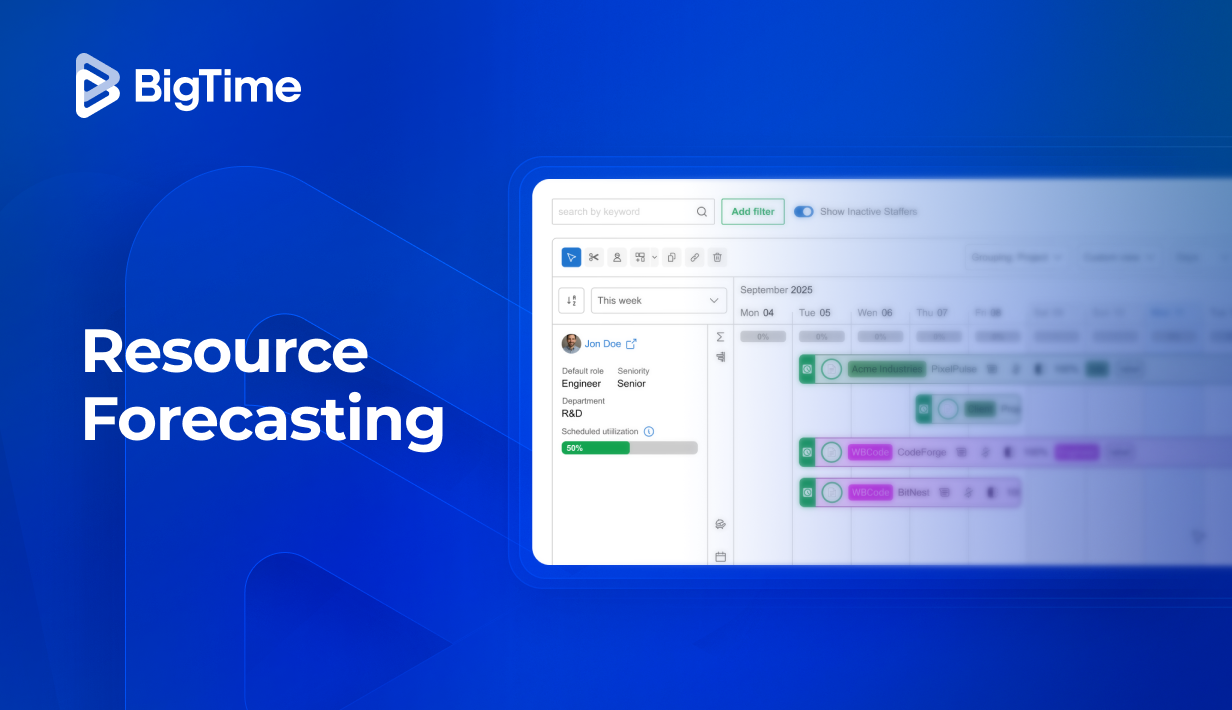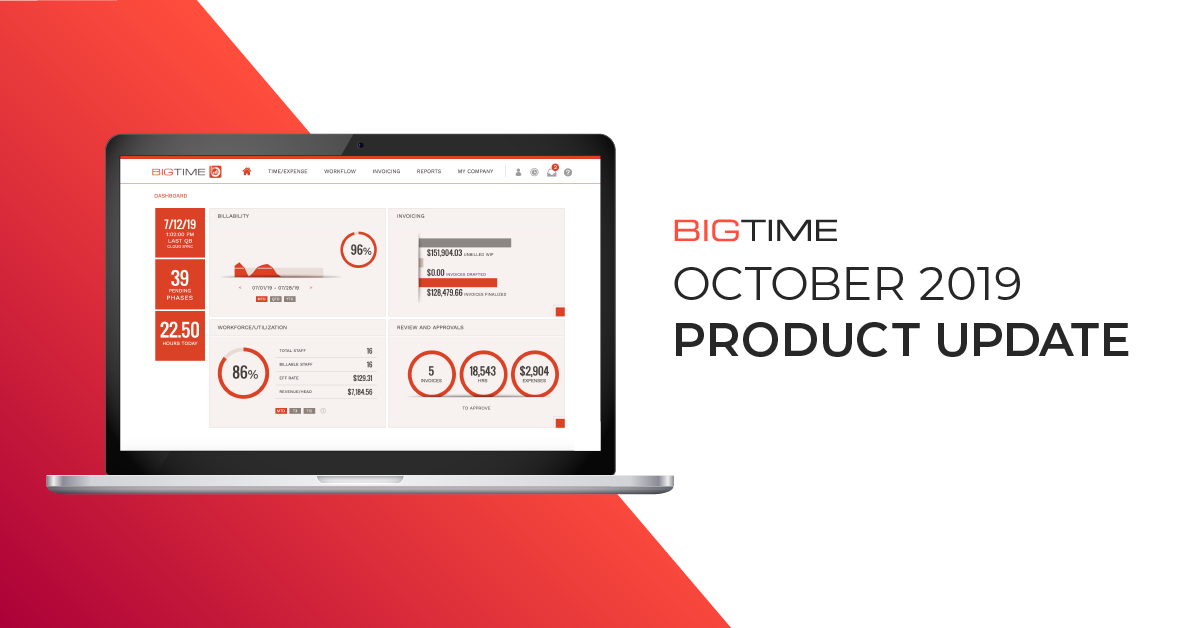For many project managers, resource management begins and ends with assigning people to projects. But there’s much more beneath the surface—especially when it comes to anticipating the needs of future projects. That’s where resource forecasting comes in.
Done right, it offers valuable insights into what lies ahead, helping you plan with confidence. And with our guide, you’ll have everything you need to forecast effectively—without missing a thing.
What’s in this article?
- What is resource forecasting – definition
- The best resource forecasting techniques for professionals
- The benefits of resource forecasting
What Is Resource Forecasting? Definition
Resource forecasting is the process of predicting an organization’s future resource needs—typically personnel, skills, or capacity—based on upcoming project demands, historical trends, and business goals. As a result, it helps resource manageers avoid bottlenecks, make informed staffing decisions and make a more efficient use of talent.
Therefore, by definition, resource forecasting answers questions such as:
- What project resources will the company need in the weeks and months to come?
- Will my team members encounter any allocation issues, such as low utilization rate or schedule conflicts?
- How many people do I need to hire, if any?
- Does my company need to find additional project for the employees that were not allocated?
- How does the current resource allocation affects my budget and overall company profitability?

Resource forecasting – examples
Examples of resource forecasting can include:
- Predicting the number of software developers needed for an upcoming product launch based on past feature development timelines.
- Estimating design team workload for seasonal marketing campaigns by reviewing historical demand patterns.
- Planning for additional support staff during peak service periods using rolling forecasts.
- Allocating internal training resources to upskill employees ahead of a new technology rollout.
Key Aspects of Resource Forecasting
There are a few key aspects of resource forecasting that no predictions can go without. Those include:
- Accurate Data – Strong resource forecasts depend on clean, consistent records from past and current projects, including utilization rates, workloads, and timelines. Without accurate data, predictions quickly lose relevance.
- Clear Goals – Knowing what success looks like and identifying success metrics ensures resource planning aligns with broader business objectives.
- Regular Updates – Forecasts should evolve as projects shift. Frequent updates help account for changing scopes, deadlines, or resource availability, keeping plans realistic.
- Cross-Team Input – Involving multiple stakeholders provides a fuller view of capacity, skills, and competing priorities, reducing the risk of conflicts or oversights.
- Technology Support – Modern resource management tools streamline forecasting with real-time updates, utilization tracking, and scenario planning, enabling faster, more informed decisions.
What Are The Four Principles of Forecasting?
- Accuracy – Forecasts are only as good as the data behind them. Using reliable historical records, current project metrics, and validated assumptions ensures your predictions reflect reality and support sound decision-making.
- Timeliness – Market conditions, project scopes, and resource availability can change quickly. Frequent updates keep your forecasts relevant, allowing you to respond before small issues become major setbacks.
- Consistency – Using a standard approach, whether it’s the same formulas, tools, or data sources, makes it easier to compare forecasts across teams and projects.
- Flexibility – Even the best forecasts can’t predict every twist. Building adaptability into your process allows you to reallocate resources or adjust budgets without derailing project goals.
Resource Forecasting Techniques For Professionals
The goal of the resource forecasting process is simple: to identify which specialists will be needed to carry out key operations. However, there’s no one-size-fits-all approach—different businesses require different forecasting techniques based on their structure, workflow, and goals. Below are some of the most commonly used methods.
Historical Data Analysis
The key to forecasting future project needs often lies in examining the past—and that’s exactly the principle behind historical data analysis. This technique involves reviewing data from previous projects, including resource utilization, timelines, workloads, and outcomes.
By identifying patterns and similarities between past and upcoming initiatives, project managers can make informed predictions about future resource availability and demand. When historical data is well-documented and reliable, this method can significantly improve accuracy in project management and resource planning and help avoid both overallocation and underutilization of resources.
Trend Analysis
To enhance the accuracy of resource planning, resource managers can go beyond simply referencing past projects. By leveraging existing data, they can conduct trend analysis—a long-term examination of patterns in resource usage over time to anticipate future demands.
This technique involves analyzing project timelines collectively to uncover recurring trends, shifts in workload, and evolving resource requirements. Consequently, trend analysis is particularly effective for organizations experiencing steady growth or cyclical project demand, where continuous improvement plays a key role in optimizing resource forecasting.
Rolling Forecasts
In dynamic project environments where conditions change rapidly, traditional static forecasting may fall short – even when paired with other techniques, such as resource leveling or ongoing resource scheduling. That’s where rolling forecasts come in.
Rolling forecasts rely on real-time data and regular review cycles to adjust resource planning in response to shifting project scopes, timelines, and business priorities. Rather than locking in predictions months in advance, this approach enables ongoing refinement, making it easier to stay aligned with actual demand. It’s especially valuable for agile organizations that prioritize responsiveness and want to maintain accuracy in resource allocation amid uncertainty or frequent change.
An example of editing project tasks in BigTime’s resource management tool
However, to get the most out of rolling forecasts, it’s best to use dedicated resource management software. These tools often include features like task dependencies, automated alerts, and real-time updates that help project managers avoid errors and adapt quickly. With the right software in place, forecasting future project requirements becomes much more accurate—even in fast-paced, constantly changing environments.
Resource Capacity Planning
Accurately forecasting future resource needs isn’t just about anticipating demand—it also requires a clear understanding of current capacity. That’s the core idea behind resource capacity planning.
This technique for resource forecasting focuses on evaluating the availability and workload of existing team members to determine whether your organization can meet upcoming project demands. By comparing available resource capacity with forecasted work, project managers can identify potential gaps, overloads, or areas where additional support may be needed.
Capacity overview in BigTime
Scenario Planning
When uncertainty is high and the future feels unpredictable, scenario planning becomes a valuable technique for accurate resource forecasting.
By exploring multiple outcomes using this resource forecasting technique, project managers can assess the potential impact of different variables like project delays, client changes, or shifts in workload. This approach helps teams prepare for volatility by building flexibility into their resource plans. Scenario planning not only supports better risk management but also empowers organizations to make strategic decisions with confidence—even when the road ahead isn’t entirely clear.
Nominal Group Technique
When diverse perspectives are needed to make accurate predictions, the Nominal Group Technique (NGT) offers a structured, collaborative approach to resource forecasting. This method gathers insights from a group of experts—such as project managers, team leads, or department heads—who independently generate ideas, then discuss and rank them collectively to reach a prioritized consensus.
By combining individual expertise with group deliberation, NGT helps uncover potential resource needs, risks, and constraints that may not be evident through data alone and might affect both resource forecasting and resource management. It’s particularly useful in complex or ambiguous project environments, where past data may be limited or where expert judgment plays a key role.
Ratio Analysis
When resource forecasting needs to be both efficient and data-driven, ratio analysis offers a practical and scalable solution. This technique uses predefined ratios—typically derived from historical project data—to estimate future resource requirements based on key project metrics such as budget, duration, or scope. For example, if past projects consistently required one developer for every $50,000 in project budget, that ratio can be applied to forecast staffing needs for similar upcoming initiatives.
Software-Based Forecasting
As projects grow in complexity and speed, manual forecasting methods can fall short. That’s where software-based forecasting steps in—leveraging technology to automate and enhance the accuracy of resource planning. This technique uses dedicated resource management tools, often powered by advanced algorithms, machine learning, and real-time data integration.
These platforms analyze historical performance, current workloads, capacity, and project pipelines to generate dynamic, data-driven forecasts. Features like scenario modeling, utilization tracking, and predictive analytics help project managers make faster, more informed decisions and make their resource forecasting more precise.
Software-based forecasting is especially valuable for organizations managing multiple projects simultaneously or operating in fast-changing environments. By streamlining forecasting and reducing human error, it enables more agile, responsive resource management.

The Benefits of Resource Forecasting
Forecasting resources is the key to numerous benefits rooted in improved project execution. Below you will find the list of advantages you might enjoy after adapting the process.
Improved Project Planning and Delivery
Resource forecasting in human resource management allows organizations to accurately estimate the personnel, skills, and capacity needed to complete upcoming projects. By understanding future demand ahead of time, project managers can build more realistic schedules, avoid delays, and allocate resources in alignment with project timelines.
Optimized Resource Utilization
One of the biggest challenges in project-based environments is ensuring resources are neither overbooked nor underutilized. Resource forecasting process helps strike that balance by identifying when and where resources will be needed—and when they won’t. This allows organizations to reassign, upskill, or redistribute staff accordingly.
Better Budget and Cost Control
Human resources are often the largest cost in project-based work. By forecasting human resources accurately, organizations can anticipate labor costs and plan financial resources accordingly. It helps avoid costly overstaffing, unplanned overtime, or emergency contractor fees—ultimately contributing to more predictable financial performance and higher profitability.
Enhanced Agility and Risk Management
Markets, clients, and project scopes can shift rapidly. Resource forecasting enables businesses to respond to these changes with agility. Whether it’s scaling up quickly for a high-priority project or adjusting to a downturn in demand, having forecast data on hand empowers teams to pivot without compromising quality or performance.
Informed Hiring and Outsourcing Decisions
With a clear view of future resource gaps, team’s availability and resource demand, businesses can make strategic workforce decisions. Forecasting identifies when additional headcount may be needed and whether it makes more sense to hire internally, bring in freelancers, or outsource specific functions. This avoids reactive hiring and ensures staffing levels align with actual workload projections.
Improve Resource Forecasting With Resource Management Software
Want to anticipate future resource capacity with 100% accuracy? The best way to do that is by using resource management software to simplify key processes.
How Can Resource Management Tool Help Your Project Management?
Resource management system provide project managers with:
- Centralized visibility of resource availability, workloads, and capacity across teams and projects, as well as historical data.
- Scenario planning and what-if analysis to test different staffing or timeline assumptions before making decisions
- Automated alerts and updates to keep forecasts current and flag potential resource conflicts or shortages
- Time tracking and project tools to align forecasted vs. actual effort in real time
- Strategic resource allocation across multiple projects or portfolios based on skills, availability, or project priority
- Customizable dashboards and reporting for tracking resource utilization, capacity gaps, and upcoming demand
Want to have all of those features in a single tool? Book a demo with BigTime and see how we can turn this list into a reality for your business.




